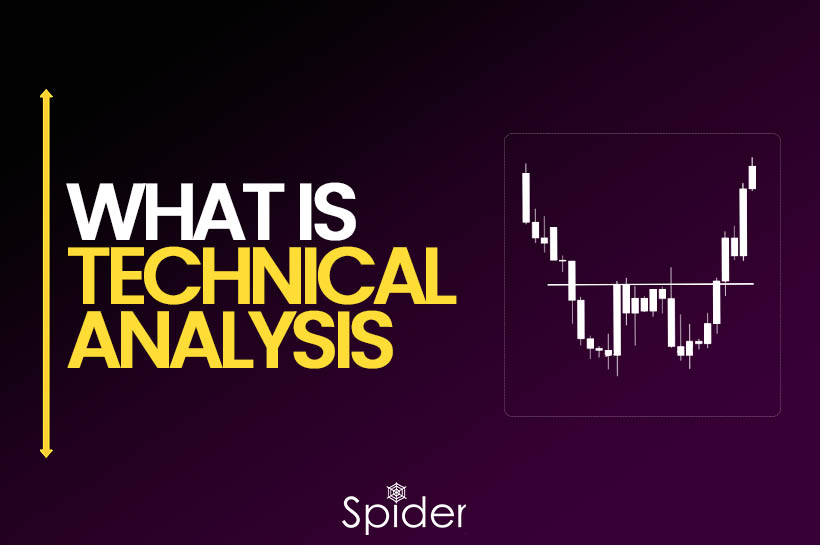Technical analysis uses historical price and volume data to identify patterns and predict future market movements. Traders use charts and tools to decide when to buy or sell assets, assuming that trends will repeat. It’s commonly used alongside fundamental analysis, which looks at a company’s finances to determine its value.
What is Technical Analysis?

Technical analysis is a trading methodology to forecast a financial asset’s future direction based on its historical price and volume data. It involves analyzing charts and applying various technical indicators to identify trends, patterns, and potential support and resistance levels.
By using technical analysis, traders aim to make informed decisions about when to buy or sell an asset, considering factors such as market trends, volatility, and trading volumes.
What Differentiates a technical analysis from a fundamental analysis?
Technical analysis and fundamental analysis are two different approaches used by traders and investors to analyze financial assets.
The key difference between these two methods lies in the type of data used to make investment decisions.
- Data Used:
The primary difference between technical analysis and fundamental analysis lies in the type of data used to make investment decisions.
Technical analysis relies on charts and historical price data,
while fundamental analysis focuses on the underlying economic, financial, and industry factors that affect an asset’s value. - Methodology:
Technical analysis involves the study of charts and patterns to identify trends and potential entry and exit points.
On the other hand, fundamental analysis involves examining a company’s financial statements, earnings, management, competitors, and industry trends to determine the intrinsic value of an asset. - Time Horizon:
Technical analysis is often used for short-term trading,
while fundamental analysis is more commonly used for long-term investing. - Subjectivity:
Technical analysis is often criticized for being subjective since it relies on the interpretation of charts and patterns.
In contrast, fundamental analysis is generally seen as more objective since it is based on objective data such as financial statements and industry trends.
In summary, technical analysis and fundamental analysis are two different approaches used to analyze financial assets, and the key differences lie in the type of data used, methodology, time horizon, and subjectivity. Traders and investors may choose to use one or both methods based on their personal preferences and trading styles.
What are the steps to implement technical Analysis on a Chart?
Here are the steps for conducting technical analysis on a chart:
- Identify the Asset
- Choose the Chart Type
- Determine the Timeframe
- Identify Trends
- Spot Patterns
- Use Technical Indicators
- Determine Support and Resistance Levels
- Analyze Market Sentiment
Identify the Asset:
The first step in technical analysis is selecting an asset or security, like stocks or currencies, to analyze. Then, gather historical price data, including opening, closing, high, and low prices over a specific time frame. Analyzing an asset’s price movements is crucial, and technical indicators can help identify patterns, trends, and entry/exit points. Technical analysis predicts future price movements based on past data, which tends to repeat itself. Choosing the right asset to analyze is essential for successful technical analysis.
Choose the Chart Type:
After selecting an asset to analyze, the next step is to choose the type of chart to use, such as line, bar, or candlestick charts. Charts display an asset’s price data in a visual format, making it easier to identify trends and patterns. Different chart types may show the same data in different ways, and traders may prefer one type over another based on personal preference or trading strategy. Below is an example types of chart used for technical analysis in Spider Software.

Determine the Timeframe:
After selecting an asset and chart type, the next step in technical analysis is to decide on the timeframe for analysis. This could be days, weeks, or months depending on the trader’s preference. The timeframe is important as it determines the amount of historical data that is considered when analyzing the asset’s price movements. Below Given is an example of Bank Nifty chart on different time frames.

Identify Trends:
The next step in technical analysis is to look for trends in the price movements of the asset. These trends can be uptrends, downtrends, or sideways trends. This helps traders identify the general direction of the asset’s price movement, which is important for making informed trading decisions.

Spot Patterns:
When analyzing charts for stocks, it is important to look for certain patterns like Triangles, Head and Shoulders, Rounding, or Double Tops / Double Bottoms. These patterns can suggest when it might be a good time to buy or sell stocks. By paying attention to these patterns, you may be able to identify potential opportunities to make profitable trades.
Use Technical Indicators:
To confirm trends and figure out when to buy or sell stocks, you can use technical indicators like moving averages, oscillators, and relative strength index (RSI). These tools can help you identify potential entry and exit points for your trades. By using these indicators, you can make more informed decisions about when to buy or sell stocks.
Determine Support and Resistance Levels:
When analyzing stock prices, it’s important to look for support and resistance levels. These levels act as barriers that prices may struggle to break through. A support level is the price at which a stock has historically bounced back up from, while a resistance level is the price at which a stock has struggled to move past. By paying attention to these levels, you can gain insights into potential buying and selling opportunities for stocks.
Analyze Market Sentiment:
It’s important to keep track of market sentiment, news, and events that could affect the price of assets. Positive or negative sentiment can impact the demand for an asset and cause its price to fluctuate. Additionally, significant news events or announcements can cause sudden price movements. By staying informed about these factors, you can make more informed decisions about when to buy or sell assets.
By following these steps, traders can conduct technical analysis on a chart and make more informed decisions about when to enter or exit trades based on technical analysis.
Conclusion:
In conclusion, technical analysis is an important tool for traders to analyze and make decisions about buying and selling stocks. By analyzing charts and using technical indicators, traders can identify potential trends and entry and exit points for trades. It’s also important to pay attention to key support and resistance levels and market sentiment, news, and events that could impact the price of assets. By using technical analysis alongside fundamental analysis and market research, traders can make more informed decisions and increase their chances of making profitable trades.
_________________________________________________________________________________________________________
Disclaimer: The information provided in this Blog is for educational purposes only and should not be construed as financial advice. Trading in the stock market involves a significant level of risk and can result in both profits and losses. Spider Software & Team does not guarantee any specific outcome or profit from the use of the information provided in this Blog. It is the sole responsibility of the viewer to evaluate their own financial situation and to make their own decisions regarding any investments or trading strategies based on their individual financial goals, risk tolerance, and investment objectives. Spider Software & Team shall not be liable for any loss or damage, including without limitation any indirect, special, incidental or consequential loss or damage, arising from or in connection with the use of this blog or any information contained herein.






5 thoughts on “Beginners Guide: How To Analyze a Chart in a Technical way”